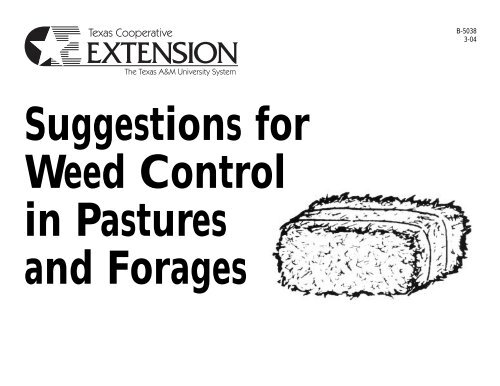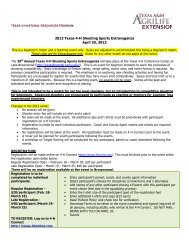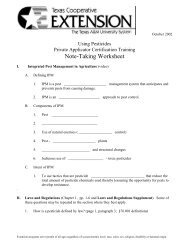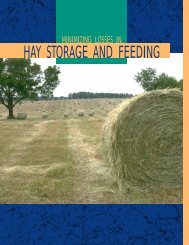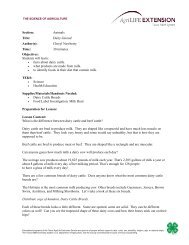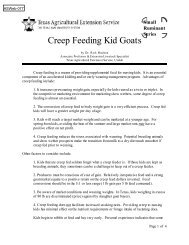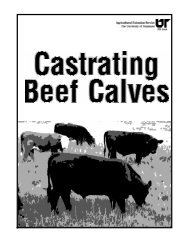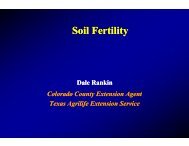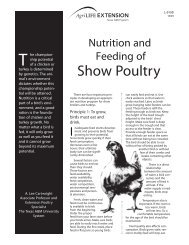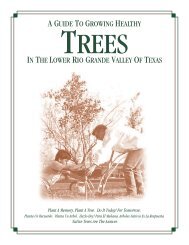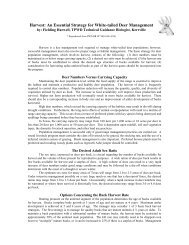Suggestions for Weed Control in Pastures and ... - Texas Forages
Suggestions for Weed Control in Pastures and ... - Texas Forages
Suggestions for Weed Control in Pastures and ... - Texas Forages
You also want an ePaper? Increase the reach of your titles
YUMPU automatically turns print PDFs into web optimized ePapers that Google loves.
B-50383-04<strong>Suggestions</strong> <strong>for</strong><strong>Weed</strong> <strong>Control</strong><strong>in</strong> <strong>Pastures</strong><strong>and</strong> <strong>Forages</strong>
<strong>Suggestions</strong> <strong>for</strong> <strong>Weed</strong> <strong>Control</strong> <strong>in</strong> <strong>Pastures</strong> <strong>and</strong> <strong>Forages</strong>Paul A. Baumann, Ph.D., Professor <strong>and</strong> Extension <strong>Weed</strong> Specialist<strong>Texas</strong> Cooperative ExtensionThe <strong>Texas</strong> A&M University SystemTable Page Table Page1 Bermudagrass pastures—newly sprigged..............................................4 7 Dormant, semidormant or actively grow<strong>in</strong>g alfalfa2 Dormant bermudagrass pastures..........................................................4 <strong>and</strong> some clovers ........................................................................93 Pasture sod suppression <strong>and</strong> renovation ..............................................4 8 W<strong>in</strong>ter pastures <strong>for</strong> graz<strong>in</strong>g only (wheat, oats, rye,4 Permanent grass pastures <strong>and</strong> established grass crop ............................5 barley, ryegrass <strong>and</strong> mixtures thereof) ......................................125 Sorghum-sudan hybrids (<strong>for</strong>age types) ................................................8 9 Graz<strong>in</strong>g/hay restrictions <strong>for</strong> pasture herbicides ..............................136 Alfalfa <strong>and</strong> clover—new plant<strong>in</strong>gs ......................................................8 Boom Sprayer Calibration ............................................................14Boomless Sprayer Calibration........................................................15The suggestions conta<strong>in</strong>ed here<strong>in</strong> are based primarily on herbicide labels, research by the <strong>Texas</strong> Agricultural Experiment Station <strong>and</strong> <strong>Texas</strong> Cooperative Extension. Theuse of product names is not <strong>in</strong>tended as an endorsement of the product or of a specific manufacturer, nor is there any implication that other <strong>for</strong>mulations conta<strong>in</strong><strong>in</strong>gthe same active chemical are not equally as effective. Product names are <strong>in</strong>cluded solely to aid readers <strong>in</strong> locat<strong>in</strong>g <strong>and</strong> identify<strong>in</strong>g the herbicides suggested.The <strong>in</strong><strong>for</strong>mation given here<strong>in</strong> is <strong>for</strong> educational purposes only. Reference to commercial products or trade names is made with the underst<strong>and</strong><strong>in</strong>g that no discrim<strong>in</strong>ationis <strong>in</strong>tended <strong>and</strong> no endorsement by <strong>Texas</strong> Cooperative Extension is implied.This publication is no substitute <strong>for</strong> the herbicide product labels! It is <strong>in</strong>tended to serve only as a guide <strong>for</strong> controll<strong>in</strong>g weeds <strong>in</strong> pasture <strong>and</strong> <strong>for</strong>ages. Labeledrates <strong>and</strong> restrictions change constantly, there<strong>for</strong>e, consult the product label be<strong>for</strong>e use.<strong>Weed</strong>s can be controlled <strong>in</strong> cropl<strong>and</strong> through cultural, mechanical <strong>and</strong> chemical means. Wise use of these <strong>in</strong>dividual methods or a comb<strong>in</strong>ation of them manage weedseffectively without caus<strong>in</strong>g economic loss or harm<strong>in</strong>g the environment. Decid<strong>in</strong>g which practice to use will depend largely on the weed(s) be<strong>in</strong>g controlled <strong>and</strong> the<strong>in</strong>festation level. Also, the crop be<strong>in</strong>g planted will play a major role <strong>in</strong> determ<strong>in</strong><strong>in</strong>g when to use mechanical measures.Considerations <strong>for</strong> cultural <strong>and</strong> mechanical weed control <strong>in</strong>clude:1. Remove light or spotty <strong>in</strong>festations of weeds by h<strong>and</strong> hoe<strong>in</strong>g or spot cultivation to prevent spread<strong>in</strong>g weed seed, rhizomes or roots. Exercise caution when plow<strong>in</strong>gperennial weeds, be<strong>in</strong>g careful to prevent the transport <strong>and</strong> spread of plant parts to other areas of the field.2. Use weed-free plant<strong>in</strong>g seed to protect aga<strong>in</strong>st weed <strong>in</strong>festations <strong>in</strong> the row <strong>and</strong> the <strong>in</strong>troduction of new weed species.3. Thoroughly clean harvest<strong>in</strong>g equipment be<strong>for</strong>e mov<strong>in</strong>g from one field to the next, or require it of the custom harvesters be<strong>for</strong>e they enter your fields.4. Use mechanical tillage to remove <strong>in</strong>itial weed flushes prior to plant<strong>in</strong>g, thereby reduc<strong>in</strong>g or elim<strong>in</strong>at<strong>in</strong>g the potential <strong>for</strong> cont<strong>in</strong>ued <strong>in</strong>festation.5. Consider the economics of us<strong>in</strong>g mechanical cultivation alone <strong>for</strong> weed control <strong>in</strong> the crop, especially where annual weed <strong>in</strong>festations are light.6. Practice rotation to crops that physically out-compete certa<strong>in</strong> weeds, result<strong>in</strong>g <strong>in</strong> their gradual decl<strong>in</strong>e.3
Table 1. Bermudagrass pastures—newly spriggedProductApplication rate(Herbicide common name) per acre<strong>Weed</strong>s controlled Company (broadcast) Time to apply RemarksAnnual grasses <strong>and</strong> annual <strong>Weed</strong>master ® 1 to 2 qts. Preemergence 7 - 10 days For use after plant<strong>in</strong>g vegetative propagules (stolons)broadleaf weeds (2,4-D + dicamba) after plant<strong>in</strong>g. of hybrid bermudagrass. Reduced control may beBASFexpected if weeds are allowed to reach 1 <strong>in</strong>ch tallbe<strong>for</strong>e application or if germ<strong>in</strong>ation occurs 10 daysafter application. Consult <strong>Weed</strong>master supplementallabel <strong>for</strong> further <strong>in</strong><strong>for</strong>mation.Table 2. Dormant bermudagrass pasturesProductApplication rate(Herbicide common name) per acre<strong>Weed</strong>s controlled Company (broadcast) Time to apply RemarksAnnual broadleaf <strong>and</strong> grass Gramoxone Extra ® 12.8 oz. Postemergence dur<strong>in</strong>g Do not pasture or mow <strong>for</strong> hay until 40 daysweeds <strong>in</strong>clud<strong>in</strong>g little barley (paraquat dichloride) March. after treatment. Gramoxone Extra ® is a restrictedSyngentause herbicide <strong>and</strong> is poisonous. Use of surfactant willimprove the per<strong>for</strong>mance of this herbicide.Annual grasses <strong>and</strong> weeds <strong>in</strong> Roundup Ultra ® 1 - 4 pts. Active weed growth be<strong>for</strong>e Only one application per year per field. ApplicationCoastal bermudagrass (glyphosate) bermuda growth (dormant must be at least 60 days be<strong>for</strong>e graz<strong>in</strong>g or harvest.Monsanto bermudagrass). Use only on fields that have an established st<strong>and</strong> ofbermudagrass where some temporary <strong>in</strong>jury ordiscoloration can be tolerated. Do not use wherecool-season legumes are a major part of the <strong>for</strong>agecomponent.Table 3. Pasture sod suppression <strong>and</strong> renovationProductApplication rate(Herbicide common name) per acre<strong>Weed</strong>s controlled Company (broadcast) Time to apply RemarksSod suppression Gramoxone Extra ® 12.8 oz. Postemergence <strong>in</strong> late Do not graze <strong>in</strong> treated areas until 60 days after(paraquat dichloride) summer or early fall to sod treatment or until w<strong>in</strong>ter annual seedl<strong>in</strong>gs are 9Syngenta not > 3 <strong>in</strong>ches tall. Apply <strong>in</strong>ches tall. Gramoxone Extra ® is a restricted usebe<strong>for</strong>e or at time of seed<strong>in</strong>g herbicide <strong>and</strong> is poisonous. Us<strong>in</strong>g a surfactant willw<strong>in</strong>ter annuals.improve the per<strong>for</strong>mance of this herbicide.4
Table 3. Pasture sod suppression <strong>and</strong> renovation (cont<strong>in</strong>ued)ProductApplication rate(Herbicide common name) per acre<strong>Weed</strong>s controlled Company (broadcast) Time to apply RemarksBroadleaf weeds Roundup Ultra ® 0.5 to 5 qts. Apply be<strong>for</strong>e plant<strong>in</strong>g <strong>for</strong>age Use <strong>for</strong> pasture, hay crop renovation <strong>and</strong> labeled(glyphosate) grasses <strong>and</strong> legumes. weeds. Note: Remove domestic livestock be<strong>for</strong>eMonsantoapplication <strong>and</strong> wait 8 weeks after applicationbe<strong>for</strong>e graz<strong>in</strong>g or harvest<strong>in</strong>g.Broadleaf weeds Roundup Ultra ® Spot treatment. Apply dur<strong>in</strong>g active growth. Labeled <strong>for</strong> <strong>for</strong>age grasses <strong>and</strong> legumes, <strong>in</strong>clud<strong>in</strong>g(glyphosate) 1 to 2% solution For perennials, apply dur<strong>in</strong>g bahiagrass, bermudagrass, bluegrass, fescue, ryegrass,Monsanto (1 to 2 qts. per 25 gals. seedhead <strong>for</strong>mation. alfalfa <strong>and</strong> clover. No more than one-tenth of anyof water)one acre should be treated at any time.Table 4. Permanent grass pastures <strong>and</strong> established grass cropsProductApplication rate(Herbicide common name) per acre<strong>Weed</strong>s controlled Company (broadcast) Time to apply RemarksAnnual <strong>and</strong> perennial grasses such Plateau ® 4 to 12 oz. (refer to Postemergence after 100% Bermudagrass growth suppression after treatmentas field s<strong>and</strong>bur, large crabgrass, (imazapic) label <strong>for</strong> weed specifics) bermudagrass green-up. should be expected. The severity <strong>and</strong> longevity ofgreen foxtail, barnyardgrass, BASF this suppression will be m<strong>in</strong>imized if bermudagrassbroadleaf signalgrass, <strong>Texas</strong>is actively grow<strong>in</strong>g at the time of application <strong>and</strong>panicum, johnsongrass, vaseygrass,good grow<strong>in</strong>g conditions prevail follow<strong>in</strong>gnutsedge spp, <strong>and</strong> numerousapplication. Consult label regard<strong>in</strong>g varietalbroadleaf weeds. Suppression ofsensitivity. Application uni<strong>for</strong>mity <strong>and</strong> accuracy isbahiagrass, dallisgrass, <strong>and</strong>essential. After 2004, Plateau ® will be available onlysmutgrass.through government agencies.Annual broadleaf weeds. For <strong>Texas</strong> 2,4-D ® am<strong>in</strong>e or low volatile 1 pt. to 1 qt. Postemergence when weeds Do not apply to newly seeded grasses until the grassbullnettle, spray <strong>in</strong> early bloom ester (4 lb./gal. product) are activelygrow<strong>in</strong>g. is well established or after head<strong>in</strong>g beg<strong>in</strong>s. Do notstage. See label <strong>for</strong> specific (2,4-D) apply when grass is <strong>in</strong> boot to milk stage if grass seedperennial weeds. Several manufacturers production is desired. Do not graze dairy animalson treated areas with<strong>in</strong> 7 days after treatment.Us<strong>in</strong>g a surfactant will improve the per<strong>for</strong>mance ofthis herbicide. Note: White <strong>and</strong> arrowleaf clovershave tolerated 0.5 lb./A of 2,4-D applied <strong>in</strong>February or March <strong>in</strong> East <strong>Texas</strong>. Either<strong>Weed</strong>master ® or Grazon P+D ® will give bettercontrol of perennial weeds than 2,4-D ® alone.5
Table 4. Permanent grass pastures <strong>and</strong> established grass crops (cont<strong>in</strong>ued)ProductApplication rate(Herbicide common name) per acre<strong>Weed</strong>s controlled Company (broadcast) Time to apply RemarksAnnual broadleaf weeds. <strong>Weed</strong>master ® 1 pt. to 1 qt. Postemergence when weeds As above. Do not graze meat animals <strong>in</strong> treated(cont<strong>in</strong>ued) (2,4-D + dicamba) You can tank mix 0.25 are actively grow<strong>in</strong>g. areas with<strong>in</strong> 30 days of slaughter. Treated grassesBASF to 0.5 pt. of Banvel ® may be harvested <strong>for</strong> hay, but do not harvestwith 0.75 to 1.5 pts.with<strong>in</strong> 37 days of treatment. Banvel ® alone is2,4-D am<strong>in</strong>e or lowlabeled <strong>for</strong> use <strong>in</strong> grass pastures. Consult label <strong>for</strong>volatile esterspecific recommendations. Us<strong>in</strong>g a surfactant will(4 lbs./gal. <strong>for</strong>m) improve the per<strong>for</strong>mance of this herbicide.Note: For Banvel ® alone <strong>in</strong> a rope wick, 1:3 watermixture is labeled.Grazon P+D ® 1 to 4 pts As above. New legume seedl<strong>in</strong>gs may not be successful if(Picloram + 2,4-D) You can tank mix 0.25 planted with<strong>in</strong> 1 year after apply<strong>in</strong>g herbicide. DoDow AgroSciences to 0.75 pt. Tordon 22K ® not transfer livestock onto broadleaf crop areaswith 1 to 3 pts. 2,4-D ®without first allow<strong>in</strong>g 7 days of graz<strong>in</strong>g onam<strong>in</strong>e or low volatileester (4 lbs./gal. <strong>for</strong>m)untreated grass pasture. Tordon 22K ® (Picloram)alone is labeled <strong>for</strong> grass pastures. Consult label <strong>for</strong>specific recommendations. Us<strong>in</strong>g a surfactant willimprove the per<strong>for</strong>mance of this herbicide.Johnsongrass, smutgrass, Roundup Ultra ® Wick or other Dur<strong>in</strong>g active weed growth. Remove domestic livestock be<strong>for</strong>e application <strong>and</strong>vaseygrass, silverleaf nightshade, (glyphosate) applicators. 1:2, 1 gal. For perennials apply at wait 14 days after application be<strong>for</strong>e graz<strong>in</strong>g <strong>and</strong>milkweed, hemp dogbane, Monsanto <strong>in</strong> 2 gals. of water seedhead <strong>for</strong>mation. harvest<strong>in</strong>g. No more than one-tenth of any acreragweed, sunflowershould be treated at a time. Further applications maybe made <strong>in</strong> the same area at 30-day <strong>in</strong>tervals.Annual grasses <strong>and</strong> weeds <strong>in</strong> Roundup Ultra ® 16 oz. Active weed growth be<strong>for</strong>e Only one application per year per field. Spr<strong>in</strong>gCoastal bermudagrass (glyphosate) bermuda growth or follow<strong>in</strong>g application must occur 60 days be<strong>for</strong>e graz<strong>in</strong>g orMonsanto the first cutt<strong>in</strong>g of bermuda harvest. After first cutt<strong>in</strong>g application, wait 28be<strong>for</strong>e bermuda starts days be<strong>for</strong>e graz<strong>in</strong>g or harvest.regrowth.Annual broadleaf weeds, some Cimarron ® 0.1 to 0.3 oz. Apply when weeds are No graz<strong>in</strong>g restriction. Has residual soil activity so itperennial broadleaf weeds <strong>and</strong> (metsulfuron) actively grow<strong>in</strong>g. may affect the follow<strong>in</strong>g crops: ryegrass, alfalfa <strong>and</strong>bahiagrass DuPont clover highly sensitive to Ally ® . Ally ® can be tankmixedwith 2,4-D, Grazon P+D ® , Tordon 22K ® ,Banvel ® , <strong>Weed</strong>master ® , <strong>and</strong> Remedy ® accord<strong>in</strong>g toCimarron Max ® Consult label. label. Rate <strong>for</strong> bahiagrass control is 0.3 oz./A. Us<strong>in</strong>g(metsulfuron + dicamba + 2,4-D)a surfactant will improve the per<strong>for</strong>mance of thisDuPontherbicide.6
Table 4. Permanent grass pastures <strong>and</strong> established grass crops (cont<strong>in</strong>ued)ProductApplication rate(Herbicide common name) per acre<strong>Weed</strong>s controlled Company (broadcast) Time to apply RemarksSmutgrass <strong>and</strong> other weeds <strong>in</strong> Velpar L ® 2.75 to 4.5 pts. Warm <strong>and</strong> moist soil Only one application per year. Oak trees are verybermudagrass <strong>and</strong> bahiagrass (hexaz<strong>in</strong>one) conditions—weeds actively sensitive to Velpar ® L. Do not graze or feed treatedDuPont grow<strong>in</strong>g. <strong>for</strong>age or hay with<strong>in</strong> 60 days of application. Us<strong>in</strong>ga surfactant will improve the per<strong>for</strong>mance of thisherbicide. Some <strong>for</strong>age grass <strong>in</strong>jury may occur.Annual broadleaf weeds, annual Amber ® 0.28 to 0.56 oz Postemergence applications No graz<strong>in</strong>g restrictions. Has residual soil activity so itryegrass <strong>and</strong> annual bromegrass (triasulfuron) to pastures when weeds are may affect follow<strong>in</strong>g crops: ryegrass, bromegrass,Syngenta <strong>in</strong> an early stage of active alfalfa, <strong>and</strong> clovers highly sensitive to Amber ® .growth. Amber ® can be tank-mixed with 2,4-D ® , Banvel ® ,Grazon P + D ® , <strong>Weed</strong>master ® <strong>and</strong> <strong>Weed</strong>one ® LV6accord<strong>in</strong>g to label. Us<strong>in</strong>g a surfactant will improvethe per<strong>for</strong>mance of this herbicide.Annual broadleaf weeds <strong>and</strong> Rave ® 3.5 to 5.0 oz. Postemergence when weeds For use <strong>in</strong> bermudagrass pastures <strong>and</strong> some nativesuppression of western ragweed (triasulfuron + dicamba) are actively grow<strong>in</strong>g. grasses, consult label. Treated areas cannot beSyngentagrazed by lactat<strong>in</strong>g dairy animals <strong>for</strong> 7 days afterapplication. Animals cannot be removed fromtreated areas <strong>for</strong> slaughter less than 30 days afterFuego ® Consult label. application. Do not apply Rave until at least 60(triasulfuron + dicamba)days after emergence of newly seeded grasses orSyngentasprigg<strong>in</strong>g of bermudagrass.7
Table 5. Sorghum-sudan hybrids (<strong>for</strong>age types)ProductApplication rate(Herbicide common name) per acre<strong>Weed</strong>s controlled Company (broadcast) Time to apply RemarksAnnual weeds <strong>and</strong> grasses AAtrex ® 4L 3.2 to 4 pts. Preemergence: Apply dur<strong>in</strong>g Apply only on <strong>Texas</strong> Gulf Coast <strong>and</strong> Blackl<strong>and</strong>AAtrex N<strong>in</strong>e-O ® 1.7 to 2.6 lbs. or shortly after plant<strong>in</strong>g. areas. In case of plant<strong>in</strong>g failure, sorghum or corn(atraz<strong>in</strong>e)may be replanted. Do not make a second application.Syngenta Postemergence: Apply If orig<strong>in</strong>ally applied <strong>in</strong> a b<strong>and</strong> <strong>and</strong> sorghum or corn2.4 pts./A (4L) or 1.3 lbs./A is replanted <strong>in</strong> untreated row middles, this product(N<strong>in</strong>e-O) when sorghum is may be applied <strong>in</strong> a b<strong>and</strong> to the second plant<strong>in</strong>g. Use6 to 12 <strong>in</strong>ches tall. Do not low rates where organic matter is 1 to 1.5% <strong>and</strong> highapply postemergence <strong>in</strong> rates on soil with more than 1.5% organic matter.liquid fertilizer solution. Use only on medium <strong>and</strong> f<strong>in</strong>e textured soil. Note:Do not graze or feed <strong>for</strong>age from treated areas <strong>for</strong>21 days after application. 2,4-D can be usedpostemergence <strong>for</strong> broadleaf weed control <strong>in</strong>sorghum sudan <strong>and</strong> millets.Annual broadleaf weeds <strong>Weed</strong>master ® 1 pt. to 1 qt. Postemergence when weeds Do not graze meat animals <strong>in</strong> treated areas with<strong>in</strong>(2,4-D + dicamba) are actively grow<strong>in</strong>g. 30 days of slaughter. Do not graze lactat<strong>in</strong>g dairyBASFanimals <strong>in</strong> treated areas with<strong>in</strong> 7 days of treatment.Do not harvest <strong>for</strong> hay with<strong>in</strong> 37 days oftreatment. Us<strong>in</strong>g a surfactant will improve theper<strong>for</strong>mance of this herbicide.Table 6. Alfalfa <strong>and</strong> clover—new plant<strong>in</strong>gsProductApplication rate(Herbicide common name) per acre<strong>Weed</strong>s controlled Company (broadcast) Time to apply RemarksAnnual grasses <strong>and</strong> some annual Balan ® 1.5 EC 3 qts. on coarse <strong>and</strong> Preplant; <strong>in</strong>corporate be<strong>for</strong>e Incorporation equipment should be a t<strong>and</strong>em disc,broadleaf weeds (benef<strong>in</strong>) medium soils, 4 qts. seed<strong>in</strong>g alfalfa. PTO-driven tillers, cultivators or hoes. Use only onDow AgroSciences on f<strong>in</strong>e soils. alfalfa, birdsfoot trefoil <strong>and</strong> clover (alsike, lad<strong>in</strong>o <strong>and</strong>red). Note: Balan ® is also labeled as a preplanttreatment be<strong>for</strong>e plant<strong>in</strong>g alsike <strong>and</strong> lad<strong>in</strong>oclovers.Annual grasses <strong>and</strong> some annual Eptam ® 7E 3.5 pts. Preplant; <strong>in</strong>corporate Temporary crop stunt<strong>in</strong>g <strong>and</strong> seal<strong>in</strong>g of the firstbroadleaf weeds (EPTC) immediately follow<strong>in</strong>g the leaves will occur if conditions <strong>for</strong> germ<strong>in</strong>ation <strong>and</strong>Syngenta application. growth are not optimum. Adequate ra<strong>in</strong>fall orirrigation will relieve crop symptoms. Do not use onwhite dutch clover.8
Table 7. Dormant, semidormant or actively grow<strong>in</strong>g alfalfa <strong>and</strong> some clovers (refer to product label)ProductApplication rate(Herbicide common name) per acre<strong>Weed</strong>s controlled Company (broadcast) Time to apply RemarksAnnual broadleaf weeds <strong>and</strong> S<strong>in</strong>bar ® 80W 0.5 to 1.5 lbs. Be<strong>for</strong>e or after emergence of Treat only semidormant or dormant st<strong>and</strong>sannual grasses (terbacil) weeds, but be<strong>for</strong>e they are 2 established <strong>for</strong> 1 year or more.DuPont<strong>in</strong>ches tall or across.Dormant alfalfa: Make a s<strong>in</strong>gle application <strong>in</strong> thefall after plants become dormant or <strong>in</strong> the spr<strong>in</strong>gbe<strong>for</strong>e new growth beg<strong>in</strong>s.9Semidormant or nondormant varieties: Apply <strong>in</strong>fall or w<strong>in</strong>ter after last cutt<strong>in</strong>g or <strong>in</strong> spr<strong>in</strong>g be<strong>for</strong>enew growth starts.Note: Do not use on seedl<strong>in</strong>g alfalfa or alfalfagrassmixtures. Do not apply to established st<strong>and</strong>safter new growth starts <strong>in</strong> the spr<strong>in</strong>g. Do notapply on snow-covered or frozen ground as crop<strong>in</strong>jury may result.Annual broadleaf weed 2,4-DB 1 to 3 qts. Use 1 to 2 Postemergence when clovers Labeled <strong>for</strong> seedl<strong>in</strong>g <strong>and</strong> established alfalfa, seedl<strong>in</strong>gSeveral manufacturers qts. if weeds are less have 2 to 4 trifoliate leaves. birdsfoot trefoils, seedl<strong>in</strong>g alsike clover, seedl<strong>in</strong>gthan 1 <strong>in</strong>ch high, 2 tolad<strong>in</strong>o clover <strong>and</strong> seedl<strong>in</strong>g red clover. Us<strong>in</strong>g a surfac-3 qts. if weeds are 1 to tant will improve the per<strong>for</strong>mance of this herbicide.3 <strong>in</strong>ches high.Note: Do not graze or feed seedl<strong>in</strong>g clovers with<strong>in</strong>60 days after application. Do not feed hay fromtreated crops to livestock with<strong>in</strong> 30 days afterapplication. Do not use on established cloversgrown <strong>for</strong> seed.Grasses <strong>and</strong> certa<strong>in</strong> broadleaf Kerb ® 50W 1 to 1.5 lbs. Preemergence to weeds Effective with dependable ra<strong>in</strong>fall or overheadweeds (pronamide 0.5 to 0.75 lb.) dur<strong>in</strong>g fall or w<strong>in</strong>ter months irrigation. With low ra<strong>in</strong>fall or furrow irrigation,Dow AgroSciences <strong>in</strong> established legumes or <strong>in</strong> <strong>in</strong>crease rate 0.5 lb. of product per acre.new plant<strong>in</strong>gs <strong>in</strong> trifoliateleaf stage.Note: Do not graze or harvest <strong>for</strong> <strong>for</strong>age ordehydration with<strong>in</strong> 25 days after application.Annual grasses <strong>and</strong> broadleaf Treflan TR-10 ® Granules 20 lbs. Preemergence to weeds after Application must be followed by 1 /2 <strong>in</strong>ch of spr<strong>in</strong>klerweeds (triflural<strong>in</strong>) January 1. irrigation or ra<strong>in</strong>fall or a flood irrigation with<strong>in</strong> 3Dow AgroSciencesdays. If this has not occurred, then shallow cultivationmust be per<strong>for</strong>med to activate <strong>and</strong> uni<strong>for</strong>mlydistribute the herbicide, tak<strong>in</strong>g care not to causesevere <strong>in</strong>jury to the alfalfa.
Table 7. Dormant, semidormant or actively grow<strong>in</strong>g alfalfa <strong>and</strong> some clovers (refer to product label) (cont<strong>in</strong>ued)ProductApplication rate(Herbicide common name) per acre<strong>Weed</strong>s controlled Company (broadcast) Time to apply RemarksAnnual grasses <strong>and</strong> broadleaf Gramoxone Extra ® 12.8 oz. Between cutt<strong>in</strong>gs <strong>in</strong> Do not treat more than 5 days after cutt<strong>in</strong>g. Do notweeds (paraquat dichloride) established st<strong>and</strong>s. cut or harvest with<strong>in</strong> 30 days of application.SyngentaGramoxone Extra ® is a restricted use herbicide <strong>and</strong>is poisonous. Us<strong>in</strong>g a surfactant will improve theper<strong>for</strong>mance of this herbicide.Annual grasses <strong>and</strong> broadleaf Pursuit DG ® 1.08 to 2.16 oz. Postemergence to seedl<strong>in</strong>g Established alfalfa applications must be made whenweeds (imazathapyr) alfalfa (2nd trifoliate or alfalfa is dormant, semidormant (less than 3 <strong>in</strong>ches ofBASF larger) or established alfalfa. regrowth) or between cutt<strong>in</strong>gs. <strong>Weed</strong>s should be 1 to3 <strong>in</strong>ches tall at application <strong>and</strong> a surfactant or crop oilconcentrate <strong>and</strong> a liquid fertilizer solution should beadded to the spray mixture. Application rate willdepend on weed species <strong>and</strong> size. Do not apply morethan 2.16 oz. per year.Annual broadleaf weeds <strong>and</strong> Karmex ® DF 1.5 to 2 lbs. Preemergence <strong>in</strong> March or Treat dormant st<strong>and</strong>s of alfalfa established <strong>for</strong> 1certa<strong>in</strong> annual grasses (diuron) early April, but be<strong>for</strong>e spr<strong>in</strong>g year or more. Do not apply to seedl<strong>in</strong>g alfalfa or toDuPont growth beg<strong>in</strong>s on the alfalfa. alfalfa-grass mixtures; do not apply to alfalfa understress from disease, <strong>in</strong>sect damage, shallow rootpenetration or alkali spots; do not apply to floodedfields or to snow-covered or frozen ground as crop<strong>in</strong>jury may result.Annual grasses <strong>and</strong> broadleaf Velpar ® 1 to 3.0 qts. on soils Preemergence or early post- Treat dormant st<strong>and</strong>s of alfalfa established <strong>for</strong> 1weeds (hexaz<strong>in</strong>one) with less than 1% emergence to the weeds <strong>in</strong> year or <strong>for</strong> one grow<strong>in</strong>g season. Do not apply toorganic matter. Consult the fall or w<strong>in</strong>ter after alfalfa actively grow<strong>in</strong>g alfalfa or to stubble betweenlabel <strong>for</strong> rates on becomes dormant or <strong>in</strong> the cutt<strong>in</strong>gs. Do not apply to snow-covered, frozenspecific soil textures. spr<strong>in</strong>g be<strong>for</strong>e new growth ground.beg<strong>in</strong>s.Velpar ® 90W 0.5 to 1.5 lbs. Note: Do not graze or feed <strong>for</strong>age or hay to live-(hexaz<strong>in</strong>one) Consult label as above. stock with<strong>in</strong> 30 days follow<strong>in</strong>g application.DuPontAnnual broadleaf weeds <strong>and</strong> Sencor ® 4 0.75 to 2.0 pts. Apply when weeds are less Treat only dormant established alfalfa. Injury maygrasses Sencor ® DF 0.5 to 1.3 lbs. than 2 <strong>in</strong>ches tall or be<strong>for</strong>e occur if metribuz<strong>in</strong> is applied earlier than 12 months(metribuz<strong>in</strong>) weed foliage is 2 <strong>in</strong>ches <strong>in</strong> after seed<strong>in</strong>g. Apply metribuz<strong>in</strong> after growth ceases <strong>in</strong>Bayer diameter. Do not apply the fall or be<strong>for</strong>e growth beg<strong>in</strong>s <strong>in</strong> the spr<strong>in</strong>g.metribuz<strong>in</strong> dur<strong>in</strong>g the firstLexone ® DF 1 to 1.3 lbs. grow<strong>in</strong>g season after seed<strong>in</strong>g. Note: Do not graze or harvest with<strong>in</strong> 28 days after(metribuz<strong>in</strong>)application.DuPont10
Table 7. Dormant, semidormant or actively grow<strong>in</strong>g alfalfa <strong>and</strong> some clovers (refer to product label) (cont<strong>in</strong>ued)ProductApplication rate(Herbicide common name) per acre<strong>Weed</strong>s controlled Company (broadcast) Time to apply RemarksAnnual broadleaf weeds 2,4-DB 1 to 3 qts. When weeds are less than 3 Treat alfalfa when plants have 2 to 4 trifoliate leaves.Several manufacturers <strong>in</strong>ches high. <strong>Weed</strong>s <strong>in</strong> the For irrigated crops, apply herbicide as soon asrosette stage should be treated possible after irrigation. Delay next irrigation <strong>for</strong> atwhen rosettes are less than 3<strong>in</strong>ches across.least 7 to 10 days after spray<strong>in</strong>g to avoid wash<strong>in</strong>g thechemical <strong>in</strong>to the root zone. 2,4-DB is a restricteduse herbicide. Use of surfactant will improve theper<strong>for</strong>mance of this herbicide. Note: Do not grazetreated crop or feed hay from treated crop to livestockwith<strong>in</strong> 60 days after application.Annual <strong>and</strong> perennial grasses Poast Plus ® 1.5 to 2.25 pts. When grass weeds are actively Poast Plus ® is absorbed through the leaves <strong>and</strong>(sethoxydim) grow<strong>in</strong>g <strong>and</strong> 4 to 25 <strong>in</strong>ches translocated to roots <strong>and</strong> buds. Active growth isBASFtall. Consult label <strong>for</strong> specific required. M<strong>in</strong>imum time from application to harvestweed recommendations. is 14 days <strong>for</strong> hay or 7 days <strong>for</strong> graz<strong>in</strong>g or green chop.Always add 1 pt./A of DASH ® or 1 qt./A of crop oilconcentrate to enhance herbicide per<strong>for</strong>mance.Consult label use rate <strong>and</strong> application tim<strong>in</strong>g specifications<strong>for</strong> different parts of <strong>Texas</strong>.11
Table 8. W<strong>in</strong>ter pastures <strong>for</strong> graz<strong>in</strong>g only (wheat, oats, rye, barley, ryegrass <strong>and</strong> mixtures thereof)ProductApplication rate(Herbicide common name) per acre<strong>Weed</strong>s controlled Company (broadcast) Time to apply RemarksAnnual broadleaf weeds Ally ® 0.1 oz. Postemergence after 2-leaf Ally ® is labeled only <strong>for</strong> use <strong>in</strong> wheat <strong>and</strong> w<strong>in</strong>ter(metsulfuron) stage but be<strong>for</strong>e boot stage of barley. If ryegrass is present, slight to severe <strong>in</strong>jury(refer to label <strong>for</strong> specific weeds DuPont wheat or barley. may occur. Ally may be comb<strong>in</strong>ed with other herbicontrolled)cides <strong>for</strong> exp<strong>and</strong>ed broadleaf weed control. Refer toAlly label <strong>for</strong> additional precautions <strong>and</strong> recommendations.Ally has no graz<strong>in</strong>g restriction <strong>in</strong> labeledcrops. Use of surfactant will improve the per<strong>for</strong>manceof this herbicide.Annual broadleaf weeds Amber ® 0.28 to 0.56 oz. Postemergence on wheat up Amber ® is labeled <strong>for</strong> use <strong>in</strong> wheat <strong>and</strong> barley only.(triasulfuron) to preboot stage or barley Applications to ryegrass or other w<strong>in</strong>ter <strong>for</strong>ages may(refer to label <strong>for</strong> specific weeds Syngenta from 2-leaf to pre-boot stage. result <strong>in</strong> severe damage. Amber may be comb<strong>in</strong>edcontrolled)with other herbicides <strong>for</strong> exp<strong>and</strong>ed weed control.Refer to the Amber label <strong>for</strong> additional precautions<strong>and</strong> recommendations. Amber has no graz<strong>in</strong>grestriction on labeled crops. Use of surfactant willimprove the per<strong>for</strong>mance of this herbicide.Annual broadleaf weeds <strong>and</strong> some MCPA ® 0.5 to 1.5 pts. Postemergence after gra<strong>in</strong> is Use higher rates <strong>for</strong> biennial <strong>and</strong> perennial weeds.biennial <strong>and</strong> perennial broadleaf Several manufacturers <strong>in</strong> 3- to 4-leaf stage, or fully Do not allow livestock to <strong>for</strong>age or graze treatedweeds tillered <strong>for</strong> the 1.5 pt. rate. areas with<strong>in</strong> 7 days be<strong>for</strong>e slaughter. Refer to thespecific MCPA product label <strong>for</strong> additional restric-(refer to label <strong>for</strong> specific weedstions <strong>and</strong> precautions. Use of surfactant will improvecontrolled)the per<strong>for</strong>mance of this herbicide.Annual broadleaf weeds <strong>and</strong> some 2,4-D ® 0.5 to 1.5 pts. Postemergence after gra<strong>in</strong> Most 2,4-D ® products are labeled <strong>for</strong> use <strong>in</strong> wheat,biennial <strong>and</strong> perennial broadleaf Several manufacturers is fully tillered. barley <strong>and</strong> rye. Application tim<strong>in</strong>gs other than thoseweedsrecommended on the <strong>in</strong>dividual 2,4-D ® productlabel may result <strong>in</strong> small gra<strong>in</strong> <strong>in</strong>jury. Use the higher(refer to label <strong>for</strong> specific weedscontrolled)rate range <strong>for</strong> biennial <strong>and</strong> perennial weeds. Consult<strong>in</strong>dividual product label <strong>for</strong> additional precautions<strong>and</strong> use restrictions. Use of surfactant will improvethe per<strong>for</strong>mance of this herbicide.12
Table 9. Graz<strong>in</strong>g/hay restrictions <strong>for</strong> pasture herbicides <strong>in</strong> days 1Lactat<strong>in</strong>g dairy Non-lactat<strong>in</strong>g Meat animalsHerbicide Graze Hay Graze Hay Graze Hay SlaughterAlly ® , Cimarron ® 0 0 0 0 0 0 NL 2Amber ® 0 30 0 30 0 30 NLBanvel ®0.5 qt./A 7 37 0 37 0 37 300.5 - 1 qt./A 21 51 0 37 0 37 301 - 2 qts./A 40 70 0 37 0 37 30Grazon P+D ® 7 30 0 30 0 30 3Plateau ® NL 2 7 NL 2 7 NL 2 7 NL 2Reclaim ® 0 0 0 0 0 0 0Remedy ®< 2 qts./A 14 NS 3 0 7 0 7 32 - 6 qts./A NS NS 14 14 - NS 4 14 14 - NS 4 3Roundup Ultra ®Spot (0.1/A) 14 14 14 14 14 14 NLRenovation1 56 56 56 56 56 56 NLTordon ® 22K 14 14 14 14 14 14 3Velpar ® 60 60 60 60 60 60 NL<strong>Weed</strong>master ® 7 37 0 37 0 37 302,4-D ® am<strong>in</strong>e 7 30 7 30 0 30 32,4-D ® ester 7 30 7 30 7 30 31 This table is only <strong>in</strong>tended to be used as a guidel<strong>in</strong>e <strong>for</strong> these restrictions. Always refer to the most current label <strong>for</strong> up-to-date recommendations.2 NL = No restrictions listed on label.3 NS = Next season.4 Refer to label <strong>for</strong> specific time <strong>in</strong>terval based upon use rate.13
Boom Sprayer Calibration1. Determ<strong>in</strong>e nozzle spac<strong>in</strong>g.2. Refer to the table below <strong>for</strong> length of calibration course.3. Mark off the calibration course on the actual area to be sprayed.4. Record the time required to drive the calibration course at the desired field gear <strong>and</strong> rpm to beused while spray<strong>in</strong>g.5. Park tractor, ma<strong>in</strong>ta<strong>in</strong> rpm used to drive course, turn on the sprayer <strong>and</strong> set it at proper pressure <strong>for</strong> desired nozzle tips.6. Catch water from one nozzle <strong>for</strong> the time equal to that required to drive the calibration course.7. Ounces of water caught = gallons per acre.8. Divide gallons per acre <strong>in</strong>to the number of gallons <strong>in</strong> spray tank to determ<strong>in</strong>e how many acres will be sprayed. Add the appropriate amount of herbicide <strong>for</strong> numberof acres to be sprayed.Chart <strong>for</strong> Nozzle Spac<strong>in</strong>g <strong>and</strong> Length of Calibration CourseNozzle spac<strong>in</strong>g (<strong>in</strong>ches) 18 20 30 40Length of calibration course* (l<strong>in</strong>ear feet) 227 204 136 102*To determ<strong>in</strong>e the calibration course <strong>for</strong> a nozzle spac<strong>in</strong>g not listed, divide the spac<strong>in</strong>g expressed <strong>in</strong> feet <strong>in</strong>to 340 (340 sq. ft. = 1/128 of an acre).Example: Calibration distance <strong>for</strong> 19-<strong>in</strong>ch nozzle spac<strong>in</strong>g = 340 ÷ 19/12 = 215 feet.14
Boomless Sprayer Calibration1. Determ<strong>in</strong>e swath width.2. Refer to the table below <strong>for</strong> the length of the calibration course.3. Mark off the calibration course.4. Record the time required to drive the calibration course at the desired field gear <strong>and</strong> rpm.5. Park the tractor, ma<strong>in</strong>ta<strong>in</strong> rpm used to drive course, turn on the sprayer.6. Catch water <strong>for</strong> the time equal to that required to drive the calibration course.7. P<strong>in</strong>ts of water caught = gallons per acre.8. Divide gallons per acre <strong>in</strong>to the number of gallons <strong>in</strong> spray tank to determ<strong>in</strong>e how many acres will be sprayed. Add the appropriate amount of herbicide <strong>for</strong> numberof acres to be sprayed.Chart <strong>for</strong> Nozzle Spac<strong>in</strong>g <strong>and</strong> Length of Calibration CourseEffective Swath Width (feet) 25 30 35 40 45 50Length of calibration course* (l<strong>in</strong>ear feet) 218 182 156 136 121 109*To determ<strong>in</strong>e the calibration course <strong>for</strong> a swath width not listed, divide the swath width expressed <strong>in</strong> feet <strong>in</strong>to 5460 (5460 sq. ft. = 1/8 of an acre).Example: Calibration distance <strong>for</strong> 32-foot swath width = 5460 ÷ 32 = 171 feet.15
The <strong>in</strong><strong>for</strong>mation given here<strong>in</strong> is <strong>for</strong> educational purposes only. Reference to commercial products or trade names is made with the underst<strong>and</strong><strong>in</strong>g that no discrim<strong>in</strong>ation is <strong>in</strong>tended<strong>and</strong> no endorsement by <strong>Texas</strong> Cooperative Extension is implied.Produced by Agricultural Communications, The <strong>Texas</strong> A&M University SystemExtension publications can be found on the Web at: http://texaserc.tamu.eduEducational programs of <strong>Texas</strong> Cooperative Extension are open to all people without regard to race, color, sex, disability, religion, age or national orig<strong>in</strong>.Issued <strong>in</strong> furtherance of Cooperative Extension Work <strong>in</strong> Agriculture <strong>and</strong> Home Economics, Acts of Congress of May 8, 1914, as amended, <strong>and</strong> June 30, 1914, <strong>in</strong> cooperation with the United StatesDepartment of Agriculture. Chester P. Fehlis, Deputy Director, <strong>Texas</strong> Cooperative Extension, The <strong>Texas</strong> A&M University System.4M, Revision


